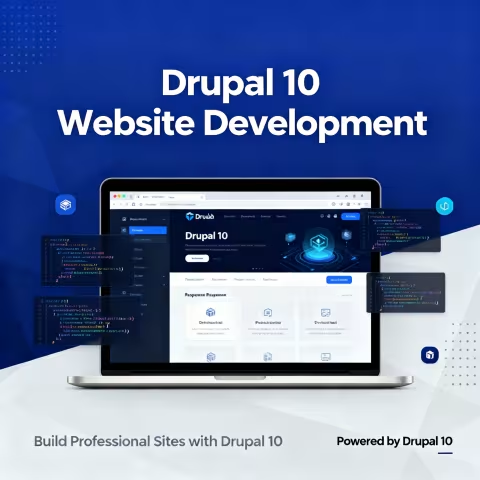Praveen Achanta
23 October 2025
Introduction: In the evolving landscape of real estate digital presence, a robust and flexible theme is essential. The current initiative aims to transform an existing HTML and CSS layout into a Drupal 10 theme that can drive a property agency’s online experience. The project emphasizes modular development, dynamic content integration, and clear documentation for seamless collaboration with channel members.
Project Goals:
- Convert HTML and CSS into a Drupal 10 theme that supports dynamic content.
- Implement a complete theme structure with well-defined sections: header, main content areas, and footer.
- Create templates that leverage Drupal’s theming system to render dynamic content.
- Establish content structures (content types and taxonomy) within Drupal to support content management and categorization.
- Share HTML/CSS assets and the Drupal setup with channel members to facilitate local hosting and implementation.
Key Development Phases:
- Initial Assessment and Planning
- Review the downloaded HTML and CSS to identify reusable components and layout patterns.
- Map the design to Drupal’s theming conventions, focusing on regions, templates, and preprocess logic.
- Define a high-level information architecture, including content types (e.g., Property Listing, Agent, Blog) and taxonomy vocabularies (e.g., Property Type, Location, Status).
- Drupal Content Architecture
- Content Types: Create core content types that reflect the agency’s needs. Examples include:
- Property Listing: title, description, price, location, features, agent reference, images, gallery, and status.
- Agent: name, contact details, photo, bio, area of expertise.
- Blog/News: title, body, author, tags, media, publish date.
- Taxonomy: Set up vocabularies to enable advanced filtering and categorization:
- Property Type (e.g., Apartment, House, Commercial)
- Location (cities, neighborhoods)
- Status (For Sale, For Rent, Sold)
- Features (Pool, Garden, Garage)
- Content Modeling: Plan field types, cardinalities, and relationships (e.g., a Property Listing may reference an Agent).
- Theme Architecture and Templates
- Create a Drupal 10 sub-theme (or a child theme) based on a base starter theme if desired.
- Define regions for layout:
- Header region (site branding, navigation, search)
- Hero/banner region
- Main content region with dynamic blocks
- Sidebar (optional)
- Footer region
- Develop template files to reflect the HTML structure, including:
- page.html.twig for overall layout
- node.html.twig and node — property-listing.html.twig for property listings
- block.html.twig for reusable sections
- views templates for listing pages (property catalogs)
- region and region — layout files as needed
- Implement dynamic content integration:
- Use Drupal’s render arrays, Twig templating, and preprocess functions to inject content (fields, images, metadata) into templates.
- Ensure responsive behavior aligns with the original HTML/CSS.
- Styling and Assets
- Translate the downloaded CSS into Drupal-friendly assets, keeping class names aligned with the markup for consistency.
- Use libraries.yaml's and attach CSS/JS via the theme’s .libraries.yml.
- Optimize images and media handling in line with Drupal media management best practices.
- Content Authoring and Workflow
- Configure content editing workflows to reflect real estate needs (e.g., property listings with publishing dates, status changes).
- Set up views for catalog pages, searchable/filterable property lists, and agent directories.
- Implement taxonomies with autocompletion and filtering to help content editors and site visitors.
- Distribution and Collaboration
- Prepare the HTML and CSS assets for sharing with channel members, along with the complete Drupal setup.
- Document setup instructions for local hosting, including prerequisites, installation steps, and a quick-start guide.
- Provide guidance on how to import/export content structures and how to deploy the theme in a staging or production environment.
Outcomes and Benefits:
- A cohesive Drupal 10 theme that faithfully translates the HTML/CSS design into a dynamic, maintainable site.
- A scalable content architecture enabling efficient management of property listings, agents, and related content.
- A templating system that supports consistent rendering across pages while allowing customization per content type.
- A clear collaboration pathway, with assets and setup instructions readily shared with channel members.
Next Steps:
- Finalize the content type definitions and taxonomy vocabularies.
- Implement the core theme scaffold, including the header, main content sections, and footer.
- Build and test templates for properties, agents, and blog content.
- Create and validate views for property catalogs and search results.
- Prepare the asset package and documentation for distribution to channel members.
Category
Pictures
- Image

Short Desc
In the evolving landscape of real estate digital presence, a robust and flexible theme is essential. The current initiative aims to transform an existing HTML and CSS layout into a Drupal 10 theme that can drive a property agency’s online experience. The project emphasizes modular development, dynamic content integration, and clear documentation for seamless collaboration with channel members.
PostID
urn:li:share:7393554454429487104
